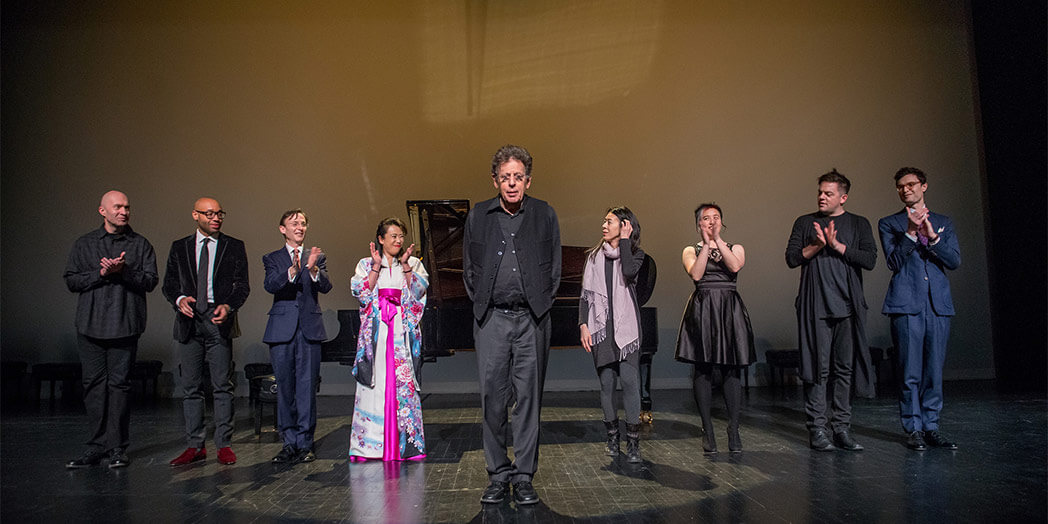From Bach’s Klavier Übung to Ligeti’s 18 Etudes, etudes are designed to both discipline and dazzle. There are those dry and musty ones that do the trick (see Clementi, Muzio), and those whose didactic elements seem unnecessary in the face of their color and character (see Chopin, Frederic). By the early 1990s Philip Glass had made his hay with operas, symphonies, and film scores. His music was diverse, driving, mystic stuff with an emphasis on harmony that made all its parts amount to sound like one massive organ. So it makes sense that the man might want to improve his chops at the keys. Via various commissions from 1991 until today, Glass composed twenty etudes. Never mind the idea that he might add to the volumes of piano studies by so many great composers since the first key was struck on a clavichord. The goal was to become a better player. Finally finished, packed houses at BAM got to feast on the New York premiere of the full set played by Glass and nine of his most piano-proficient contemporaries.
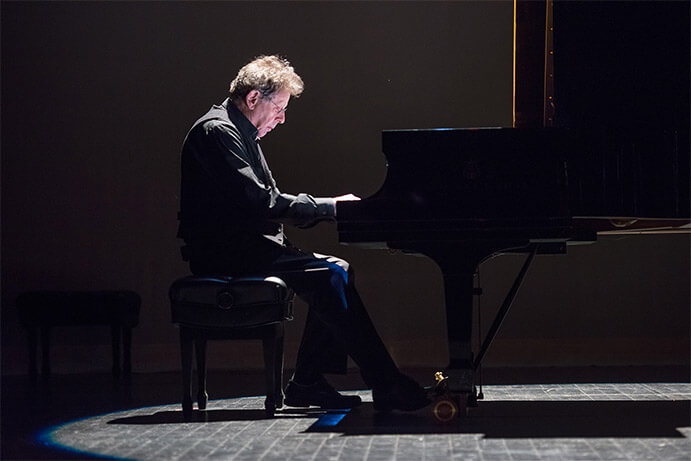
Philip Glass – Photo Credit: Stephanie Berger
A single piano seems like a measly thing in the Howard Gilman Opera House. Even the grandest of grands is downright diminutive beneath the vaulted ceiling and century-old trappings of the place. The stage was vacant apart from the Steinway and ten piano benches lined upstage. The house seemed particularly dark apart from two spotlights. One smacked into the lid of the piano and created a glistening reflection on the upstage curtain. The other shone directly on the keyboard itself. After each performer played the requisite two etudes, his or her piano stool was replaced for the next. Either all ten players had very specific adjustments to their benches (see Gould, Glenn), or this was a symbolic indication of the wonderful differences between them. Aaron Diehl, Nico Muhly, Jenny Lin, Timo Andres, Bruce Levingston, Tania Leon, Sally Whitwell (read our interview), Anton Batagov, Maki Namekawa, and Glass himself – some of them are best known as composers, others as performers. They are musicians of varied countries, ages, styles, and pedigrees. And all of them can play.
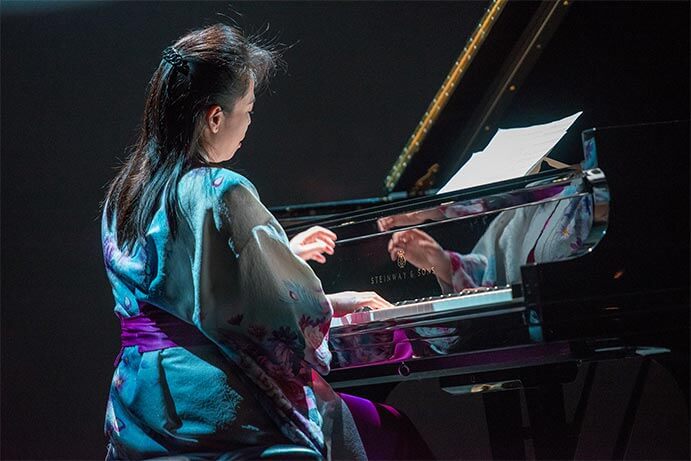
Maki Namekawa – Photo Credit Stephanie Berger
Glass went first, provoking the excitement of the crowd and ultimately drawing the attention away from himself. All things considered, the etudes have totally “worked” for Glass. In #1 he vamped on rapid arpeggios with ease and in #2 he emphasized individual notes that gleamed in the right and left hand. There was a darkness to these first two that remained consistent through the rest. They weren’t “sad,” but sometimes it’s hard to disconnect the intimate from the melancholy. There was something to the solemnity and solitude that undoubtedly comes with writing and working through these tricky pieces. It revealed itself onstage.

Anton Batagov – Photo credit Stephanie Berger
Apart from the stool-switching, there was zero theatricality to the evening. The program itself featured precious little information: “Name of Performer, Etude #__.” It was left to the players to bring the energy and excitement to the room. Young composers Nico Muhly and Timo Andres joined Glass at BAM’s Reich/Glasstravaganza in October. At that concert they performed Four Organs by Reich, a banshee of a piece in which Muhly played de facto conductor with serious verve. For etudes, #5 and #6, he had a more measured panache which was no less compelling as he traversed turbulent and dramatic music. In #9 and #10, Andres brought all the flair. #10 in particular featured a left-hand that sounded like a full brass section as it reverberated through the house.
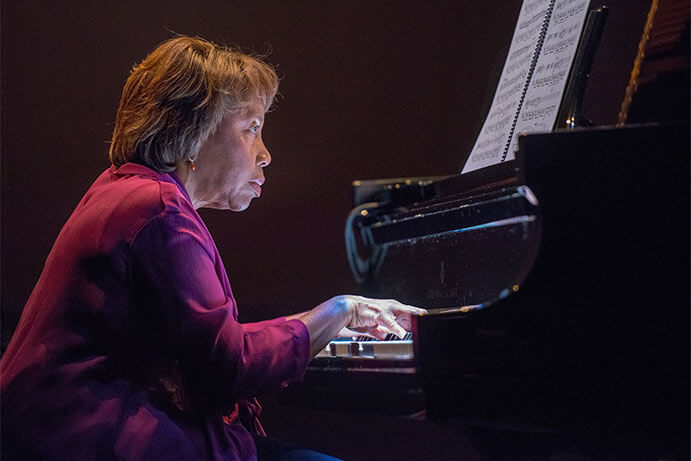
Tania Leon – Photo credit Stephanie Berger
Some of the Etudes sounded like seeds of larger Glass works written or unwritten. Played by the ebullient Sally Whitwell, #15’s obsessively rich chords hinted at an arrival that never came. It had a poppy drive reminiscent of In the Upper Room, the collection of dances Glass wrote for Twyla Tharp in 2009. Bruce Levingston was the most “piano-soloist” of all and he performed with Lisztian élan. #12 was a majestic, shimmering piece that he managed to play with both energy and tenderness. It was hard to imagine that each pianist (save for Glass) would play different pieces on night two. Each was engrossed and in love.
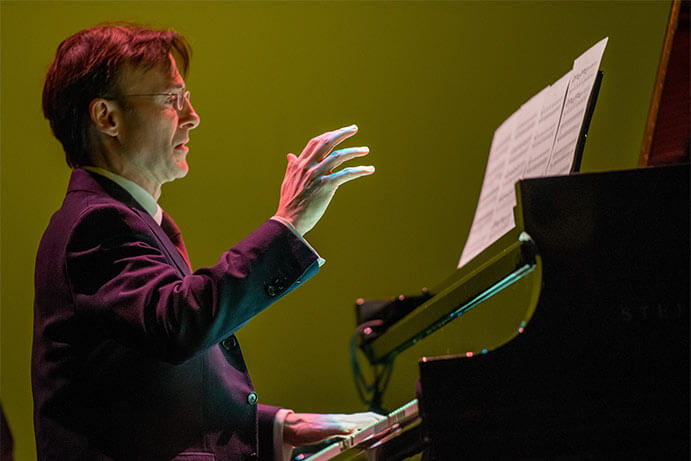
Bruce Levingston – Photo credit Stephanie Berger
The audience was too, mostly. Solo pieces for piano are perhaps the best realization of the idea that music is nothing more than a tangible, vivid encapsulation of passing time. For Glass, the space of time to realize The Etudes was twenty years. For the audience, it was two and a half hours. That was a lot of time to tune in on nothing other than the music itself and the gesticulations of those playing it. Some nodded off, others perhaps focused on the reflection of the piano as the music moved. There was a boldness in the simplicity of it all. Another strategy was to stretch the imagination and think of voyeuristically watching these pros plumb the etudes for their wisdom and beauty. That made it a sort of tableau where Glass, as he always does, set something in motion that became unstoppable.


